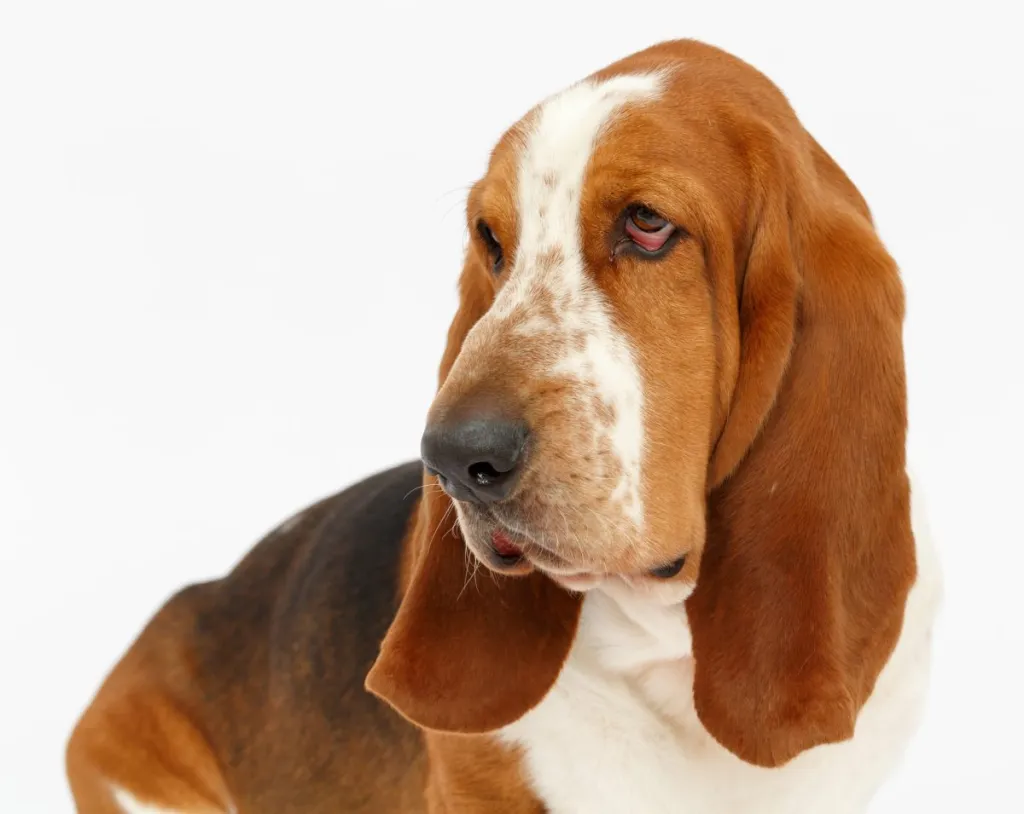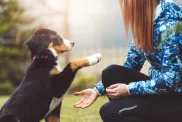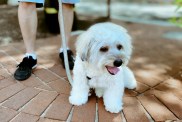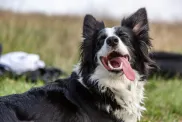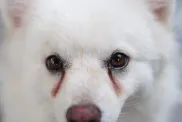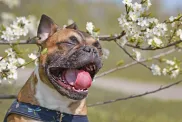The Basset Hound is a lovable and endearing dog breed that was originally bred for hunting small game, particularly rabbits. Even now, in some parts of the United States, they display their excellent hunting skills, showing their remarkable heritage. Beyond their hunting prowess, Basset Hounds are known for their laid-back and affectionate nature. This makes them the perfect family friends, especially for households with kids.
While Basset Hounds are purebred, you can also find them in shelters or under rescue groups. Adopting one gives them a loving home and fills your life with joy and companionship. Although they are purebred dogs, it’s heartening to know that you can also find Basset Hounds in shelters or under the care of rescue groups. Opting to adopt one of these adorable dogs not only gives them a loving forever home but also fills your life with boundless joy and companionship.
These delightful dogs boast unique features that add to their charm and functionality. Their long, low-set ears, known as “leathers,” play a functional role in helping them track scents, making them outstanding hunters. This breed’s distinctive baying bark and murmuring whine give them endearing voices, making them excellent conversationalists in their own charming way.
Quick Facts
Origin: The Basset Hound is a breed of dog that originated in France. They were initially bred for hunting small game, especially rabbits and hares, due to their excellent sense of smell and slow, steady pace.
Appearance: Basset Hounds are known for their distinctive physical features, including their long, droopy ears, loose skin, and short legs. They have a smooth, dense coat that comes in various colors, including tri-color (black, tan, and white), red and white, and lemon and white.
Size: They are a medium to large-sized breed. Adult Basset Hounds typically weigh between 50 to 65 pounds (22 to 29 kg) and stand about 12 to 15 inches (30 to 38 cm) tall at the shoulder.
Exercise: Despite their short legs, they enjoy outdoor activities and moderate exercise. Regular walks and playtime will keep them physically and mentally stimulated.
Grooming: Basset Hounds have a short coat that is relatively easy to maintain. Regular brushing helps keep their coat clean and reduces shedding.
Health: As with all breeds, Bassets can be prone to certain health issues. Common concerns include hip dysplasia, ear infections (due to their long ears), and obesity. Regular vet check-ups and a balanced diet can help prevent some of these issues.
Lifespan: On average, this breed lives between 10 to 12 years. Providing them with proper care, diet, and regular exercise can contribute to a longer, healthier life.
Popular Culture: This breed has gained popularity in various forms of media, including movies, TV shows, and advertising campaigns, often portrayed as a lovable and humorous character.
Scent Hound: Basset Hounds are part of the scent hound group, meaning they have an exceptional sense of smell. They have been used for scent tracking and detection work due to their olfactory abilities.
Basset Hound Temperament
Basset Hounds are gentle, friendly, and affectionate dogs. They are patient and good with children, making them ideal family pets. This breed is also intelligent and easy to train, although they can be stubborn at times. Bassets are prone to some health problems, such as obesity, hip dysplasia, and ear infections. With proper care, they can live long and happy lives.
Basset Hound Pictures
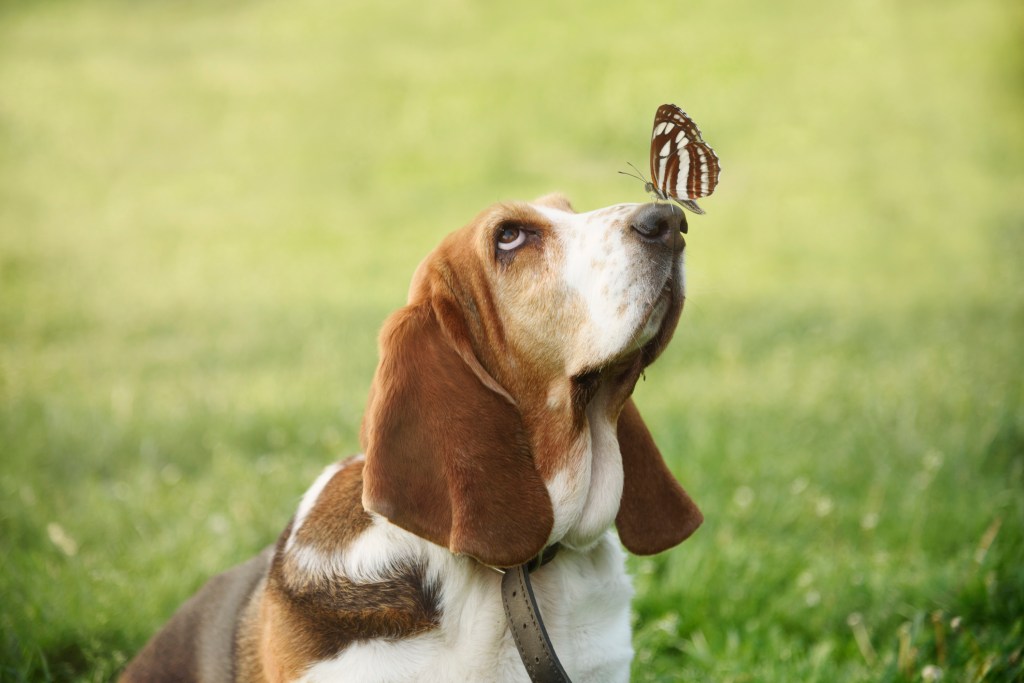
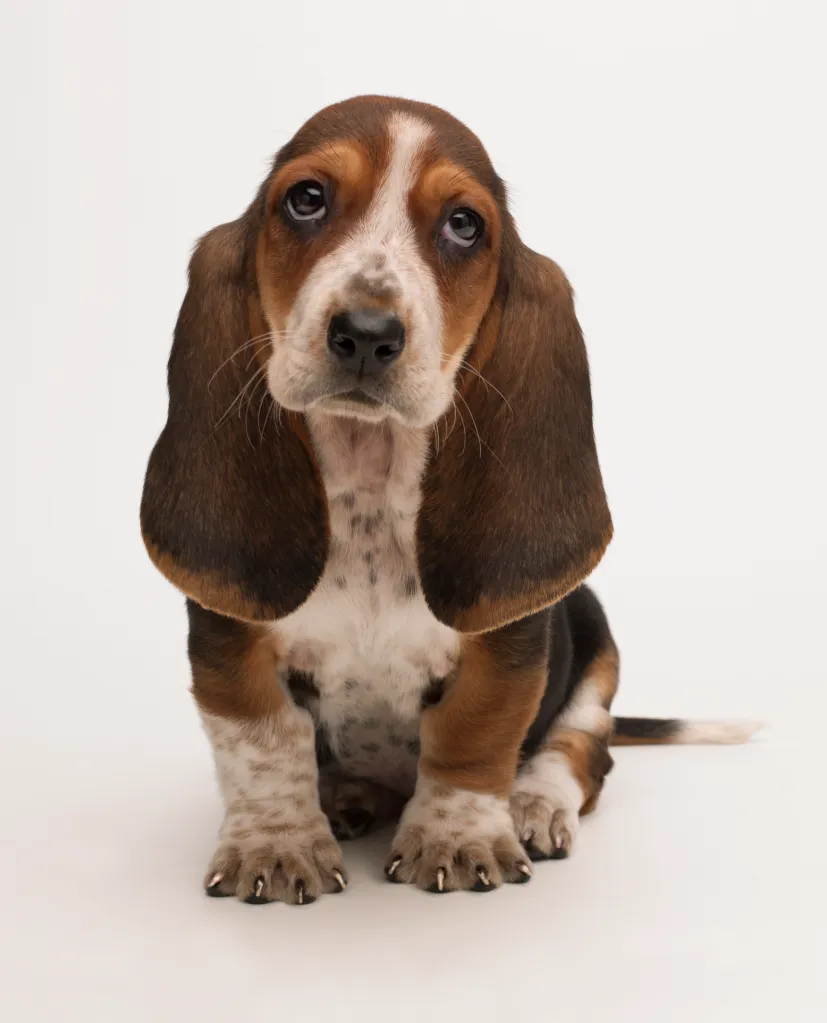
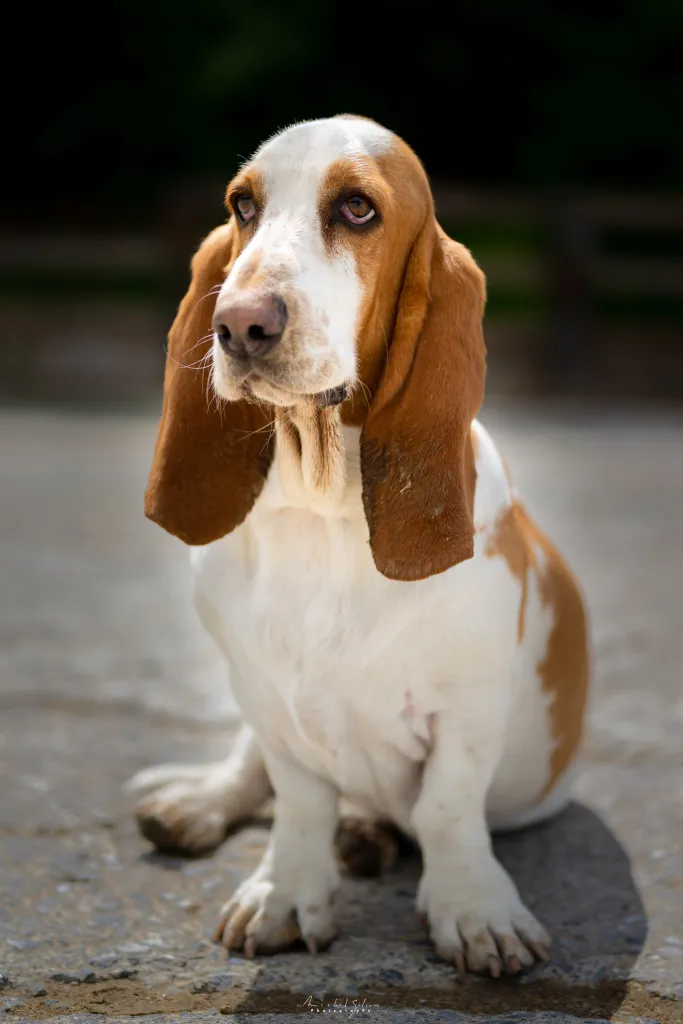
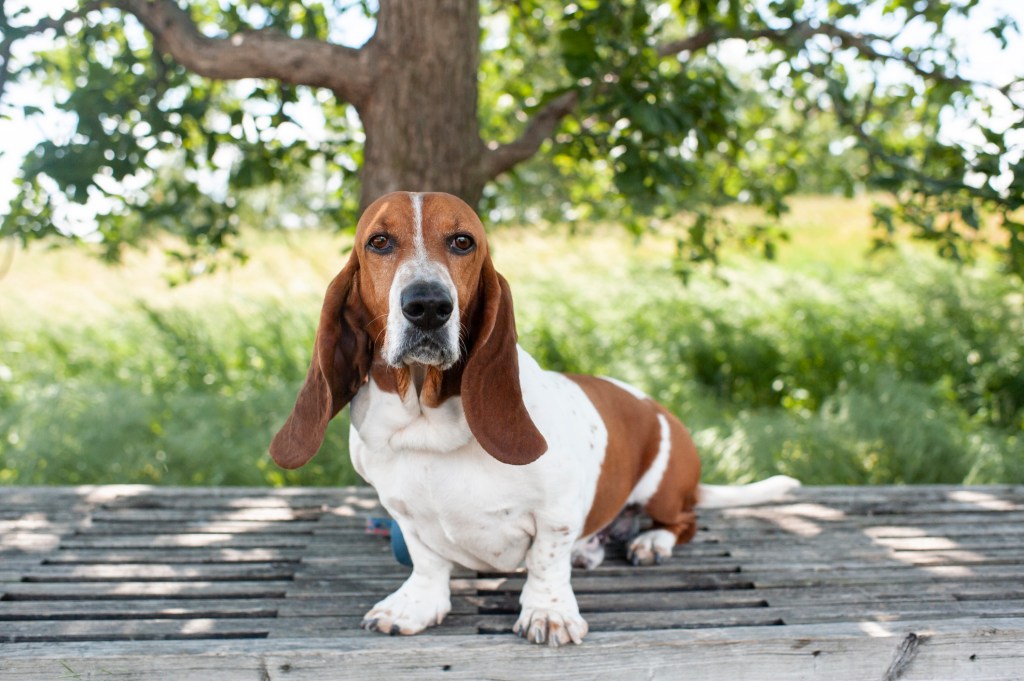
Adaptability
-
Adapts Well To Apartment Living
Looking for the best dog for your apartment? Contrary to popular belief, the suitability of dogs who adapt well to apartment living goes beyond its size. Apartment dwellers have a myriad of dog breeds to choose from as potential companions, with various factors to consider. Some large breeds can adapt well to apartment living and have lower activity levels. Others may require more space and possess higher energy levels. On the other hand, certain small dog breeds with abundant energy can still find contentment with indoor playtime or brisk walks.
However, when selecting a dog that adapts well apartments, it is essential to prioritize your neighbors. Opting for a pet that doesn’t excessively bark and behaves politely when encountering others in shared spaces like is crucial for maintaining a harmonious apartment environment.
In high-rise settings, it’s worth noting that numerous small dogs may exhibit a propensity for high energy and frequent barking. This makes them less suitable for apartment living. Therefore, desirable qualities in an apartment dog encompass being quiet, low-energy, and displaying polite behavior towards other residents.
Factors To Consider When Choosing A Dog For An Apartment
When considering dogs that adapt well to apartments, size alone should not be the sole determinant. Apartment dwellers have a wealth of dog breeds to choose from as potential furry companions. It’s important to remember that the size of your living space is just one factor to consider. While some larger breeds can adapt well to apartment living, with lower, others may require more space and have higher energy levels, making them less suitable for smaller apartments. Conversely, certain small dog breeds with higher energy levels can still thrive in apartments, finding contentment through indoor playtime or brisk walks. However, it is crucial to consider your neighbors’ comfort when selecting a dog. Opt for a pet that doesn’t bark excessively and behaves politely when interacting with others in shared spaces.
Therefore, it’s important to prioritize qualities such as being quiet, low-energy, calm indoors, and exhibiting good manners when living in close proximity to other residents. By considering these factors, you can find a dog that will adapt well to apartment living and create a harmonious living environment for everyone involved.
-
Good For Novice Owners
Some dogs are simply easier than others; they take to training better and are fairly easygoing. They’re also resilient enough to bounce back from your mistakes or inconsistencies.
Dogs who are highly sensitive, independent thinking, or assertive may be harder for a first-time dog parent to manage. You’ll get your best match if you take your dog-owning experience into account as you choose your new pooch.
If you’re new to dog parenting, take a look at 101 Dog Tricks and read up on how to train your dog!
-
Sensitivity Level
Some dogs will let a stern reprimand roll off their backs, while others take even a dirty look to heart. Low-sensitivity dogs, also called “easygoing,” “tolerant,” “resilient,” and even “thick-skinned,” can better handle a noisy, chaotic household, a louder or more assertive owner, and an inconsistent or variable routine. Do you have young kids, throw lots of dinner parties, play in a garage band, or lead a hectic life? Go with a low-sensitivity dog.
-
Tolerates Being Alone
Some breeds bond very closely with their family and are more prone to worry or even panic when left alone by their owner. An anxious dog can be very destructive–barking, whining, chewing, and otherwise causing mayhem. These breeds do best when a family member is home during the day or if you can take the dog to work.
-
Tolerates Cold Weather
Breeds with very short coats and little or no undercoat or body fat, such as Greyhounds, are vulnerable to the cold. Dogs with a low cold tolerance need to live inside in cool climates and should have a jacket or sweater for chilly walks. You can find a great jacket for your dog here!
-
Tolerates Hot Weather
Dogs with thick, double coats are more vulnerable to overheating. So are breeds with short noses, like Bulldogs or Pugs, since they can’t pant as well to cool themselves off. If you want a heat-sensitive breed, your dog will need to stay indoors with you on warm or humid days, and you’ll need to be extra cautious about exercising your dog in the heat.
All-around friendliness
-
Affectionate With Family
When it comes to unconditional love and unwavering loyalty, few animals can rival the affectionate nature of dogs. These remarkable creatures have earned their reputation as man’s best friend, and many breeds are particularly renowned for their love and devotion to their families. With their warm hearts and wagging tails, affectionate family dogs enrich the lives of their owners in countless ways.
One such breed known for its affectionate demeanor is the Golden Retriever. With their gentle temperament and friendly disposition, Golden Retrievers form deep bonds with their families. They eagerly participate in family activities, whether it’s a game of fetch in the yard or cuddling on the couch during a movie night. Their expressive eyes and ever-wagging tails are a testament to the joy they feel in the presence of their loved ones.
Another family-favorite breed is the Labrador Retriever. Renowned for their playful and patient nature, Labradors are excellent companions for children and adults alike. They readily engage in playtime with the kids, showcasing their boundless energy and enthusiasm. But when the day winds down, they seamlessly transition into loving and gentle cuddle buddies, comforting their family members with their warm presence.
Beyond specific breeds, mixed-breed dogs also have a special place in the hearts of families seeking affectionate companions. The shelter dogs, in particular, form deep connections with their adoptive families. They seem to understand the second chance they’ve been given and repay it with endless love and gratitude.
How To Know If A Dog Is Good With Families
The affectionate nature of family dogs extends beyond play and cuddles. Dogs have a remarkable ability to sense their owner’s emotions, offering comfort and support during difficult times. Whether it’s a wagging tail after a long day at work or a sympathetic nuzzle during moments of sadness, they prove time and again that they are attuned to their family’s needs.
It is important to note that not all dogs of the same breed will be equally affectionate. Some dogs may be more independent or aloof, while others may be more clingy or demanding of attention. The best way to find out how affectionate a dog is is to meet them in person and interact with them.
-
Kid-Friendly
Being gentle with children, sturdy enough to handle the heavy-handed pets and hugs they can dish out, and having a blasé attitude toward running, screaming children are all traits that make a kid-friendly dog. You may be surprised by who’s on that list: Fierce-looking Boxers are considered good with children, as are American Staffordshire Terriers (which are considered Pit Bulls). Small, delicate, and potentially snappy dogs such as Chihuahuas aren’t always so family-friendly.
**All dogs are individuals. Our ratings are generalizations, and they’re not a guarantee of how any breed or individual dog will behave. Dogs from any breed can be good with children based on their past experiences, training on how to get along with kids, and personality. No matter what the breed or breed type, all dogs have strong jaws, sharp pointy teeth, and may bite in stressful circumstances. Young children and dogs of any breed should always be supervised by an adult and never left alone together, period.
-
Dog Friendly
Friendliness toward dogs and friendliness toward humans are two completely different things. Some dogs may attack or try to dominate other dogs, even if they’re love-bugs with people; others would rather play than fight; and some will turn tail and run. Breed isn’t the only factor. Dogs who lived with their littermates and mother until at least six to eight weeks of age and who spent lots of time playing with other dogs during puppyhood, are more likely to have good canine social skills.
-
Friendly Toward Strangers
Stranger-friendly dogs will greet guests with wagging tails and nuzzles; others are shy, indifferent, or even aggressive. However, no matter what the breed, a dog who was socialized and exposed to lots of different types, ages, sizes, and shapes of people as a puppy will respond better to strangers as an adult. Remember that even friendly dogs should stay on a good, strong leash like this one in public!
Health And Grooming Needs
-
Amount Of Shedding
If you’re going to share your home with a dog, you’ll need to deal with some level of dog hair on your clothes and in your house. However, shedding does vary greatly among the breeds. Some dogs shed year-round, some “blow” seasonally, some do both, and some shed hardly at all. If you’re a neatnik, you’ll need to either pick a low-shedding breed or relax your standards. To help keep your home a little cleaner, you can find a great de-shedding tool here!
-
Drooling Potential
Drool-prone dogs may drape ropes of slobber on your arm and leave big, wet spots on your clothes when they come over to say hello. If you’ve got a laid-back attitude toward slobber, fine; but if you’re a neatnik, you may want to choose a dog who rates low in the drool department.
-
Easy To Groom
Some breeds are brush-and-go dogs; others require regular bathing, clipping, and other grooming just to stay clean and healthy. Consider whether you have the time and patience for a dog who needs a lot of grooming, or the money to pay someone else to do it.
-
General Health
Due to poor breeding practices, some breeds are prone to certain genetic health problems, such as hip dysplasia. This doesn’t mean that every dog of that breed will develop those diseases; it just means that they’re at an increased risk.
If you’re adopting a puppy, it’s a good idea to find out which genetic illnesses are common to the breed you’re interested in. You may also want to ask if your shelter or rescue has information about the physical health of your potential pup’s parents and other relatives.
-
Potential For Weight Gain
Some breeds have hearty appetites and tend to put on weight easily. As in humans, being overweight can cause health problems in dogs. If you pick a breed that’s prone to packing on pounds, you’ll need to limit treats, make sure they get enough exercise, and measure out their daily food servings into regular meals rather than leaving food out all the time.
Ask your vet about your dog’s diet and what they recommend for feeding your pooch to keep them at a healthy weight. Weight gain can lead to other health issues or worsen problems like arthritis.
-
Size
Get ready to meet the giants of the doggy world! Large dog breeds aren’t just big balls of fluff, they’re like loving, oversized teddy bears on a mission to steal your heart. Need some convincing? Let’s dive into the awesome benefits of owning one!
First things first, these pooches are a living security system! With their impressive size and thunderous barks, they’ll have any would-be intruder running for the hills. Talk about peace of mind! Plus, who needs an alarm when you’ve got a furry giant protecting your castle?
But that’s not all. Large dog breeds are all about loyalty and devotion. They’ll stick by your side through thick and thin, becoming your most dedicated bestie. Their love knows no bounds! When you have a giant fluffball showing you unconditional love, you’ll feel like the luckiest human on the planet.
Now, let’s talk about their talents. These big fellas are the ultimate working partners. With brains and brawn, they’re up for any challenge. From search and rescue missions to lending a helping paw to those in need, these dogs are superheroes in fur coats. They’ll make you proud every step of the way!
Don’t let their size fool you—these gentle giants have hearts as big as their paws. They’re incredible with kids and other pets, spreading their love like confetti. Their patience and kindness make them perfect family pets, ensuring harmony in your household.
Oh, and get ready to break a sweat! These dogs are fitness enthusiasts, and they’ll keep you on your toes. Daily walks, jogs, and play sessions will not only keep them happy and healthy but will also give you a reason to ditch the couch and join in on the fun. It’s a win-win situation!
So, if you’re ready for a dose of big love, go ahead and consider a large dog breed. They’re the best wing-dog you could ever ask for, ready to make your life a thousand times more exciting, loving, and downright awesome! Get ready for the big adventure of a lifetime!
Trainability
-
Easy To Train
Easy-to-train dogs are more adept at forming an association between a prompt (such as the word “sit”), an action (sitting), and a consequence (getting a treat) very quickly. Other dogs need more time, patience, and repetition during training.
Many breeds are intelligent but approach training with a “What’s in it for me?” attitude, in which case you’ll need to use rewards and games to teach them to want to comply with your requests.
Related:
10 Fun, Impressive Tricks You Can Teach Any Dog
-
Intelligence
Dogs who were bred for jobs that require decision making, intelligence, and concentration, such as herding livestock, need to exercise their brains, just as dogs who were bred to run all day need to exercise their bodies. If they don’t get the mental stimulation they need, they’ll make their own work–usually with projects you won’t like, such as digging and chewing. Obedience training and interactive dog toys are good ways to give a dog a brain workout, as are dog sports and careers, such as agility and search and rescue.
-
Potential For Mouthiness
Common in most breeds during puppyhood and in Retriever breeds at all ages, mouthiness means a tendency to nip, chew, and play-bite (a soft, fairly painless bite that doesn’t puncture the skin). Mouthy dogs are more likely to use their mouths to hold or “herd” their human family members, and they need training to learn that it’s fine to gnaw on chew toys, but not on people. Mouthy breeds tend to really enjoy a game of fetch, as well as a good chew on a toy that’s been stuffed with kibble and treats.
-
Prey Drive
Dogs with a high prey drive have an instinctive desire to stalk, capture, and prey upon potential food sources. Dogs who were bred to hunt, such as Terriers, have an inborn desire to chase — and sometimes kill — other animals. Anything whizzing by — such as cats, squirrels, and perhaps even cars — can trigger that instinct.
How to address a high prey drive
Off-leash adventures are too great a temptation for pups who will wander and hunt. Dogs who like to chase need to be leashed. And, even on a leash, you may experience your dog pulling on the leash to reach rodents or birds in their sight. Otherwise, these pups should be kept in a fenced area when outdoors. If your pup has a high prey drive, you’ll need a high, secure fence in your yard.
These breeds generally aren’t a good fit for homes with smaller pets that can look like prey, such as cats, hamsters, or small dogs. Breeds that were originally used for bird hunting, on the other hand, generally won’t chase, but you’ll probably have a hard time getting their attention when there are birds flying by.
Other behavioral concerns
Observing your dog’s prey drive, which is instinctual and biologically-rooted, is not the same as observing aggression. Much aggression is born of fear and anxiety, especially in the case of dog aggression toward humans.
The tendency to wander, even into oncoming traffic, can produce diasterious results for pups with predatory instincts. It can also lead to pups being bitten by snakes or attacked by other wild animals they may pursue while on the hunt.
-
Tendency To Bark Or Howl
Some breeds sound off more often than others. When choosing a breed, think about how often the dog vocalizes. Learn more about breeds with a tendency to bark or howl.
If you’re considering a hound, would you find their trademark howls musical or maddening? If you’re considering a watchdog, will a city full of suspicious “strangers” put your pup on permanent alert? Will the local wildlife literally drive your dog wild? Do you live in housing with noise restrictions? Do you have neighbors nearby? Then you may wish to choose a quieter dog.
-
Wanderlust Potential
Some breeds are more free-spirited than others. Nordic dogs such as Siberian Huskies were bred to range long distances, and given the chance, they’ll take off after anything that catches their interest. And many hounds simply must follow their noses–or that bunny that just ran across the path–even if it means leaving you behind.
Exercise needs
-
Energy Level
High-energy dogs are always ready and waiting for action. Originally bred to perform a canine job of some sort, such as retrieving game for hunters or herding livestock, they have the stamina to put in a full workday. They need a significant amount of exercise and mental stimulation, and they’re more likely to spend time jumping, playing, and investigating any new sights and smells.
Low-energy dogs are the canine equivalent of a couch potato, content to doze the day away. When picking a breed, consider your own activity level and lifestyle, and think about whether you’ll find a frisky, energetic dog invigorating or annoying.
-
Intensity
A vigorous dog may or may not have high energy, but everything they do, they do with vigor: they strain on the leash (until you train them not to), try to plow through obstacles, and even eats and drinks with great big gulps. These dynamos need lots of training to learn good manners, and may not be the best fit for a home with young kids or someone who’s elderly or frail. A low-vigor dog, on the other hand, has a more subdued approach to life.
-
Exercise Needs
Some breeds do fine with a slow evening stroll around the block. Others need daily, vigorous exercise, especially those that were originally bred for physically demanding jobs, like herding or hunting.
Without enough exercise, these breeds may put on weight and vent their pent-up energy in ways you don’t like, such as barking, chewing, and digging. Breeds that need a lot of exercise are good for outdoorsy, active people, or those interested in training their dog to compete in a high-energy dog sport, such as agility.
-
Potential For Playfulness
Some dogs are perpetual puppies — always begging for a game — while others are more serious and sedate. Although a playful pup sounds endearing, consider how many games of fetch or tag you want to play each day, and whether you have kids or other dogs who can stand in as playmates for the dog.
Basset Hound Overview
The Basset Hound is an iconic and delightful dog breed, holding a special place in history as the original “Hush Puppy dog.” They became synonymous with the famous shoe brand’s lovable mascot, captivating hearts across generations.
Basset Hounds are popular for their placid personality, short-statured, noble appearance, and remarkable hunting instincts. Originally bred for hunting small game, particularly rabbits, they have retained their remarkable scent hound abilities. Their unique features, like long, low-set ears and a distinctive baying bark, add to their charm and functionality. Basset Hounds are scent hounds with an exceptional sense of smell, second only to the Bloodhound. Their smooth, short, hard-textured coats are relatively easy to care for and usually come in a classic tri-color pattern.
Around the house, Bassets are calm, loyal, and friendly, making them great with families and other pets. Regular exercise is crucial to prevent weight gain and related health issues, as they can be hearty eaters. Bassets have a strong endurance and love to track scents, making long walks enjoyable for both them and their owners.
Training a Basset may require patience, as they can be stubborn at times. Gentle and positive training methods work best for these emotionally sensitive dogs. Their unique voices, with howls and a murmuring whine, make for delightful conversations and often lead to getting tasty treats from their adoring humans. Basset Hounds are delightful family companions, blending their hunting heritage with a gentle and affectionate temperament. Despite some idiosyncrasies like drooling and howling, their loving and relaxed nature makes them a wonderful addition to any home.
Basset Hound Highlights
-
Basset Hounds, like all hounds, may be a bit stubborn and challenging to train and housetrain. Crate training is recommended as a helpful approach. When these pups catch an intriguing scent, they can become single-minded and follow it, even if it puts them in danger. To keep them safe, always use a leash outdoors, and consider obedience classes with gentle and patient methods, as harsh training techniques are typically ineffective with hounds.
One common reason Basset Hounds end up in shelters or adoption centers is their tendency to drool excessively due to loose skin around their mouths. Additionally, they can create quite a mess while drinking. For those seeking a tidier household, a Basset Hound might not be the best fit. Flatulence can also be an issue for this breed, so consulting with a vet for a possible dietary change is recommended.
Weight management is crucial for Basset Hounds, as they have a fondness for overeating. This can lead to joint and back problems, so it’s important to portion their food appropriately based on their condition rather than following the recommendation on the bag or can. Due to their susceptibility to bloat, it’s better to feed them two or three smaller meals rather than one large meal, and keep an eye on them after eating to ensure they’re okay.
Routine ear checks and cleaning are essential for Basset Hounds, as their long ears can trap dirt and moisture, potentially causing ear infections. Expect these vocal dogs to howl, especially when left alone for extended periods. While they are strong and agile, it’s best to discourage jumping, especially out of a car, to prevent injuries.
As Basset puppies grow, be mindful of their joints and prevent overexertion and excessive jumping off furniture. Basset Hounds aren’t strong swimmers, so be cautious around swimming pools to avoid potential hazards.
Lastly, ensure you get a healthy Basset Hound from a reputable breeder who tests their breeding dogs for genetic diseases and ensures sound temperaments. Avoid purchasing from backyard breeders, puppy mills, or pet stores to support responsible breeding practices.
Basset Hound History
The history of the Basset Hound is deeply rooted in hunting and its development can be traced back to France in the 16th century. The word “Basset” is derived from the French word “bas,” meaning low, which aptly describes the breed’s characteristic short stature. Their short legs are a result of a form of dwarfism called achondroplasia, and this unique physical feature has been a defining trait throughout their history.
Basset Hounds were originally bred for hunting small game, particularly rabbits, due to their exceptional sense of smell. Their keen tracking abilities made them popular among French nobility and they quickly became a favored choice for hunting in the dense forests and challenging terrains of France. The breed’s low-to-the-ground structure allowed them to follow scent trails easily, and their long, droopy ears served as an advantage, sweeping scents up from the ground and directing them towards their keen noses.
The breed’s popularity gradually spread beyond France, and by the 19th century, Basset Hounds found their way to England, where they became a beloved breed among hunters. In the mid-1800s, the breed saw a resurgence in France under the influence of Emperor Napoleon III. He developed a passion for Basset Hounds and greatly contributed to their popularity during his reign.
In the United States, Basset Hounds were introduced in the late 19th century, and their unique appearance and charming personality quickly captured the hearts of dog enthusiasts. The American Kennel Club (AKC) officially recognized the Basset Hound in 1885, further solidifying its status as a recognized and esteemed breed.
The breed’s hunting origins are still evident in modern Basset Hounds. While they are no longer commonly used for hunting, their exceptional sense of smell and tracking abilities remain intact. Today, Basset Hounds are primarily cherished as companion animals, appreciated for their gentle and affectionate nature. Their calm and laid-back temperament makes them wonderful family pets, and their distinctive appearance has made them popular in various media, including advertisements, books, and movies.
Over the years, the Basset Hound’s endearing features and amiable personality have made them one of the most recognizable and beloved dog breeds worldwide. Despite their historical hunting heritage, they have transitioned gracefully into the role of loyal and loving family companions, enchanting people with their droopy eyes, saggy skin, and charming howls, making them a truly iconic and treasured breed.
Basset Hound Size
The Basset Hound is a medium to large-sized breed with a distinctive low-to-the-ground appearance. On average, they typically weigh between 50 to 65 pounds and stand around 13 to 15 inches in height at the shoulder. Despite their relatively heavy weight, Basset Hounds are compact dogs with a sturdy build. Their short legs and long, heavy-boned body give them a unique and endearing look. Despite their size, Bassets are surprisingly agile and can move with grace and elegance. Their physical traits, including their droopy ears and loose, wrinkled skin, contribute to their charming and iconic appearance, making them easily recognizable and loved by many.
Basset Hound Personality
Basset Hounds are known for their gentle and friendly personality, making them wonderful family pets. They are affectionate and loyal, forming strong bonds with their owners. Despite their hunting background, they are not overly aggressive and generally get along well with children and other pets. Bassets have a laid-back and relaxed demeanor, often content to lounge around the house. However, they can be stubborn at times, which may require patient and gentle training. Like every dog, Basset Hounds need early socialization — exposure to many different people, sights, sounds, and experiences — when they’re young. Socialization helps ensure that your Basset puppy grows up to be a well-rounded dog. Their distinctive baying bark and howling add to their charm and unique personality. Overall, Basset Hounds bring joy and love to their families with their endearing nature and delightful character.
Basset Hound Health
Basset Hounds are generally robust and healthy dogs, yet, like all breeds, they may be susceptible to certain health conditions. While not every Basset Hound will encounter these issues, it’s important to be well-informed if you’re considering bringing this breed into your home. When searching for a Basset Hound puppy, it becomes paramount to connect with a reputable breeder who can present health clearances for both the puppy’s parents. These health clearances serve as evidence that the dogs have undergone testing and have been cleared of specific conditions.
For Basset Hounds, comprehensive health clearances should encompass screenings for hip dysplasia (with a fair or better score), elbow dysplasia, hypothyroidism, and von Willebrand’s disease, all of which are certified by the Orthopedic Foundation for Animals (OFA). Furthermore, it is essential to obtain health clearances for thrombopathia from Auburn University and certification of normal eyes from the Canine Eye Registry Foundation (CERF). To validate these clearances, a quick visit to the OFA website (offa.org) will provide the necessary confirmation.
Remember, staying informed about potential health concerns and partnering with responsible breeders can contribute to the well-being and longevity of your Basset Hound companion.
- Gastric Dilatation-Volvulus (GDV): Also known as bloat or gastric torsion, GDV is a life-threatening condition that primarily affects deep-chested breeds like Basset Hounds. It occurs when the stomach becomes distended with gas or air and then twists, trapping the excess air and preventing the dog from belching or vomiting. This leads to a drop in blood pressure, shock, and potential organ damage. GDV can be triggered by factors such as eating one large meal a day, eating rapidly, drinking large volumes of water after eating, and exercising vigorously after meals. To reduce the risk of GDV, it’s recommended to feed multiple smaller meals, avoid strenuous activity after eating, and consider elevated feeding dishes.
- Von Willebrand’s Disease: A hereditary disorder, von Willebrand’s disease affects the dog’s blood clotting ability, leading to prolonged bleeding and mild to moderate bleeding episodes. If your Basset Hound shows signs of excessive bleeding or has a prolonged bleeding time, it’s essential to consult your veterinarian and have them tested for this condition. With proper management and precautions, affected dogs can lead a normal and happy life.
- Panosteitis (Wandering or Transient Lameness): Panosteitis is a mysterious ailment often seen in young Basset Hounds, causing sudden episodes of lameness that can vary in severity. This condition is characterized by inflammation of the long bones, which may lead to discomfort and limping. However, most puppies outgrow panosteitis by the age of two, and it doesn’t usually result in long-term problems. It’s essential for owners to be aware of this condition to avoid unnecessary surgeries and consult a specialist if necessary.
- Glaucoma: Basset Hounds are prone to glaucoma, a condition where pressure builds up inside the eye, potentially leading to optic nerve damage and vision loss. Glaucoma can be painful and requires immediate veterinary attention. If you notice any signs of squinting, tearing, redness, or bulging eyes, take your Basset Hound to the vet for a thorough eye examination.
- Allergies: Like many other breeds, Basset Hounds can suffer from allergies, which may be food-related, contact-related (such as bedding or shampoos), or inhalant allergies caused by airborne allergens like pollen and dust. Allergies can result in various symptoms, including itching, skin irritation, and ear infections. Identifying the allergen and providing appropriate treatment, which may involve dietary adjustments or medication, is essential for managing allergies in Basset Hounds.
- Patellar Luxation: Patellar luxation, also known as “slipped stifles,” is a common orthopedic issue in small dog breeds like Basset Hounds. It occurs when the patella (knee cap) is not properly aligned within the femur (thigh bone), leading to lameness and abnormal gait. In mild cases, dogs may experience temporary lameness, while severe cases may require surgical intervention to realign the patella properly and prevent further complications such as arthritis.
- Thrombopathia: Thrombopathia is a blood platelet disorder occasionally found in Basset Hounds, affecting their blood clotting ability. This condition can lead to excessive bleeding from minor injuries or surgeries. If you suspect your Basset Hound has thrombopathia, a blood test can confirm the diagnosis. With proper precautions and coordination with your veterinarian, dogs with thrombopathia can lead normal lives without major complications.
- Eyelid and Eyelash Problems: Basset Hounds are prone to eyelid conditions such as ectropion, where the eyelids turn outward, and entropion, where the eyelids roll inward, causing lashes to irritate the eye surface. These conditions can lead to discomfort, irritation, and potential eye damage. Regular eye examinations by a veterinarian can detect these issues early, and surgical correction may be necessary to alleviate the discomfort and protect the dog’s eye health.
- Intervertebral Disc Disease: Basset Hounds are especially susceptible to back problems due to their long-backed structure. Intervertebral disc disease (IVDD) can occur due to genetics, injuries, or rapid movements. IVDD can lead to symptoms like paralysis, loss of bowel and bladder control, and pain. Treatment options vary based on the severity of the condition, ranging from conservative management with crate rest and anti-inflammatory medications to surgical intervention for more severe cases.
- Ear Infections: Due to the Basset’s long, floppy ears, proper ear care is essential to prevent infections. Moisture and debris can get trapped in the ear canal, leading to bacterial or yeast infections. Regular ear cleaning, as well as addressing any signs of inflammation or odor, is crucial to maintaining good ear health in Basset Hounds.
- Obesity: Basset Hounds have a hearty appetite and can easily gain weight if overfed or not given enough exercise. Obesity can lead to various health issues, including joint problems and cardiovascular conditions. Proper portion control, a balanced diet, and regular exercise are essential to maintaining a healthy weight and preventing obesity-related health concerns.
- Hip Dysplasia: Hip dysplasia is a common orthopedic condition in Basset Hounds, where the hip joint doesn’t fit snugly, potentially leading to arthritis and lameness. Regular veterinary checkups and screening for hip dysplasia through X-rays can help identify this hereditary condition and provide appropriate management options.
- Cherry Eye: Cherry eye is a condition where the gland beneath the third eyelid protrudes, causing a red, swollen appearance in the corner of the eye, resembling a cherry. While this condition is not typically painful, it can lead to dry eye and discomfort if left untreated. Surgical removal of the gland may be necessary to address cherry eye and prevent further complications.
Basset Hound Care
Basset Hounds are typically calm dogs that adapt well to living in various environments, including small houses and apartments. While they are content indoors, it’s essential for them to live with their family, ideally with access to a yard. However, extreme heat or cold is not suitable for them, and they should not be left outdoors for prolonged periods. Despite their indoor tranquility, Basset Hounds still need regular exercise to maintain their weight and overall health. A leisurely walk with plenty of sniffing time will make them happy, but be cautious not to let them become couch potatoes, as they are prone to obesity, which can strain their joints.
When outdoors, it’s crucial to keep Bassets in a fenced yard or on a leash to prevent them from following interesting scents and wandering off. Until they are one year old, discourage jumping on and off furniture and limit stair usage to avoid undue stress on their front legs and back. Providing them with a ramp or steps can be helpful, as Bassets are not known for their jumping abilities.
Training Basset Hounds requires kindness, consistency, and positive reinforcement, especially with food rewards and praise. Harsh training methods will only make them more stubborn and less responsive. To keep their attention during training, make it interesting and engaging. Bassets have a tendency to develop selective hearing when something more exciting captures their attention.
Basset Hounds are well-suited for indoor living but still need regular exercise and training to stay healthy and well-behaved. They are independent thinkers, so positive reinforcement and consistent training methods are key to fostering a well-mannered and responsive Basset companion.
Basset Hound Feeding
Feeding your Basset Hound the right amount of high-quality dog food is essential for maintaining his health and weight. The recommended daily portion ranges from 1.5 to 2.5 cups, divided into two meals. However, keep in mind that each dog is unique, and factors such as size, age, metabolism, and activity level can influence their individual dietary needs. A highly active Basset Hound will require more food than a more sedentary one. Opting for a nutritious dog food brand is crucial, as it will provide better nourishment, meaning you won’t need to use as much to keep your furry friend satisfied. Bassets have a tendency to overeat, making them prone to obesity, so it’s crucial to measure their food and feed them twice a day, rather than free-feeding. To ensure your Basset Hound maintains a healthy weight, observe the eye test and the hands-on test: look for a visible waistline and be able to feel, but not see, his ribs with gentle pressure. Adjust his food and exercise routine accordingly if needed. For more guidance on feeding your Basset Hound, check out our comprehensive guidelines on selecting the right food, feeding puppies, and nourishing adult dogs.
Basset Hound Coat Color And Grooming
Basset Hounds boast a smooth, short coat that effectively repels dirt and water, while also providing ample protection in various weather conditions. Their loose and elastic skin gives them their charming droopy hound dog appearance. As for their colors, the breed standard allows for all hound colors, but the most common ones are tri-color (tan, black, and white), black and white, brown and white, or red and white. While lemon and white is also acceptable, it is a rare sight. On the other hand, blue Basset Hounds (gray) may be seen, but this coloring is deemed undesirable due to a recessive gene associated with potential genetic problems.
Fortunately, Basset Hounds are relatively easy to groom, aside from the need to clean their ears, facial wrinkles, and occasional drool. Their short coats make them resistant to dirt and water, so regular baths are not often required. A thorough rubdown with a bristle brush, coarse cloth, or hound glove is sufficient to maintain their coat in excellent condition. They shed throughout the year, but with weekly brushing, shedding should not be a major concern.
Basset Hounds have long ears that tend to collect dirt, making ear infections a potential issue due to poor air circulation. Cleaning the interior of their ears at least once a week with your vet’s recommended solution, wiping the outside to remove dirt, cleaning facial wrinkles with a damp cloth, and thoroughly drying them is essential. Regularly check their large paws for sores between the toes.
To ensure your Basset Hound’s dental health, brush their teeth two or three times a week to prevent tartar buildup and bacteria. Daily brushing is even better for preventing gum disease and bad breath. Additionally, trim their nails once or twice a month; if you can hear the nails clicking on the floor, they need a trim.
Start getting your Basset accustomed to grooming routines as a puppy, handling their paws, mouth, and ears frequently. Make grooming a positive experience with praise and rewards, setting the foundation for easy veterinary exams and handling as they grow into adults. With proper care and grooming, your Basset Hound will maintain a healthy and happy life.
Basset Hound Children And Other Pets
Basset Hounds have a natural affinity for children and generally establish great relationships with them. Nevertheless, it’s essential to ensure that both the Basset and the child are safe during their interactions. Teaching children the proper way to approach and interact with dogs is crucial, and supervision should always be maintained during their playtime to prevent any unintended rough behavior that may provoke the dog or vice versa. Children should be educated not to disturb a dog while it’s sleeping or eating, and they should never attempt to take away the dog’s food.
To maintain a harmonious atmosphere, it’s crucial never to leave any dog, including Bassets, unsupervised with a child. As pack-oriented animals, Basset Hounds appreciate the companionship of other dogs, and they can usually coexist peacefully with cats, especially if they are introduced to them from a young age. By fostering positive relationships and understanding the needs and boundaries of both children and Basset Hounds, you can create a safe and loving environment for everyone involved.
Basset Hound Rescue Groups
Many Basset Hounds are acquired without a proper understanding of the responsibilities that come with owning one. It’s important to recognize that there are numerous Bassets in need of adoption or fostering. While we may not have listed all the available rescues, there are plenty out there. If you don’t find a rescue organization listed in your area, consider reaching out to the national breed club or a local breed club, as they can provide valuable guidance and direct you to a reputable Basset rescue. Giving a Basset Hound a second chance through adoption or fostering can be a rewarding and compassionate choice for dog enthusiasts looking to make a positive impact.
Basset Hound Breed Organizations
Explore the following breed clubs, organizations, and associations to discover more information about the Basset Hound:
